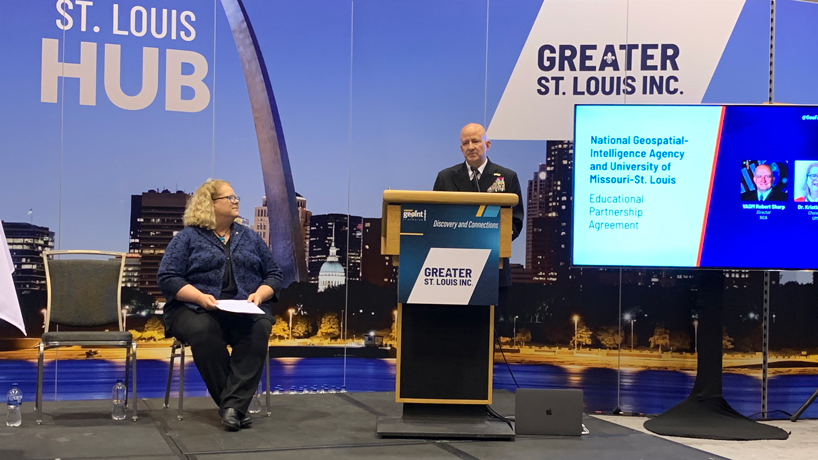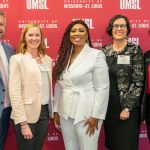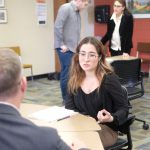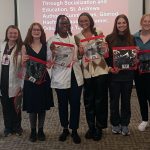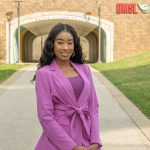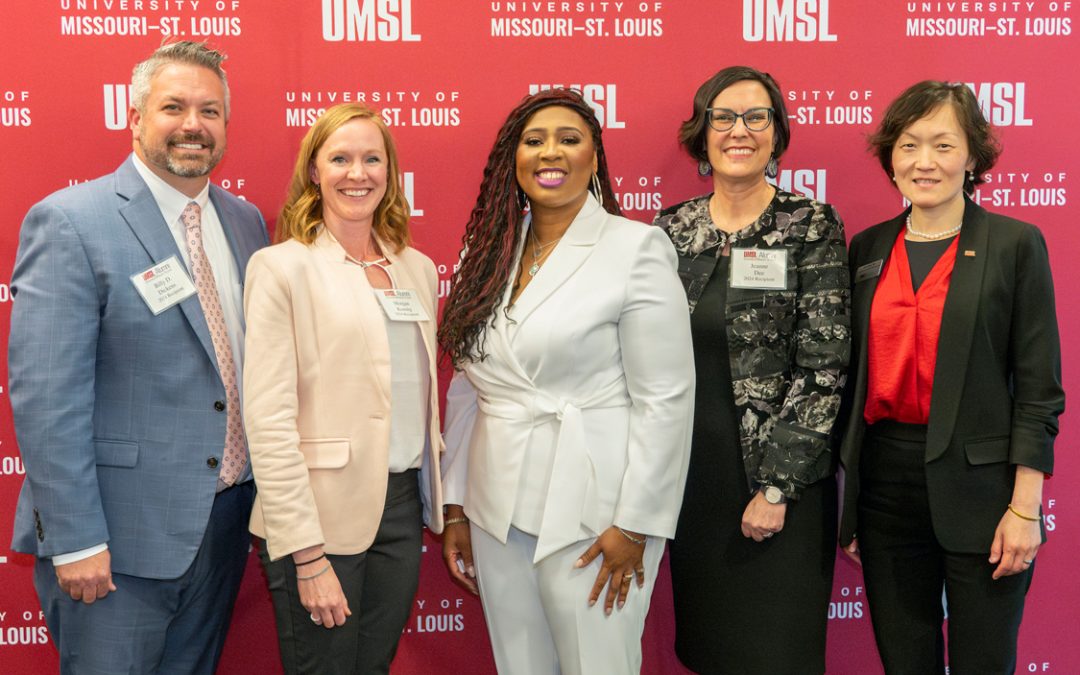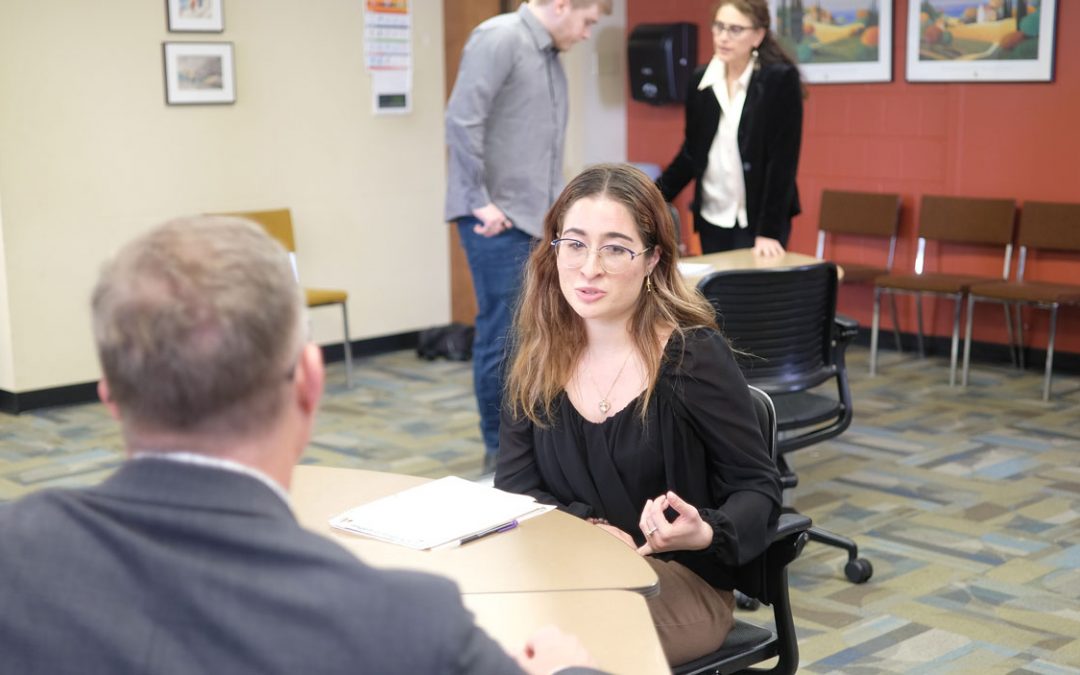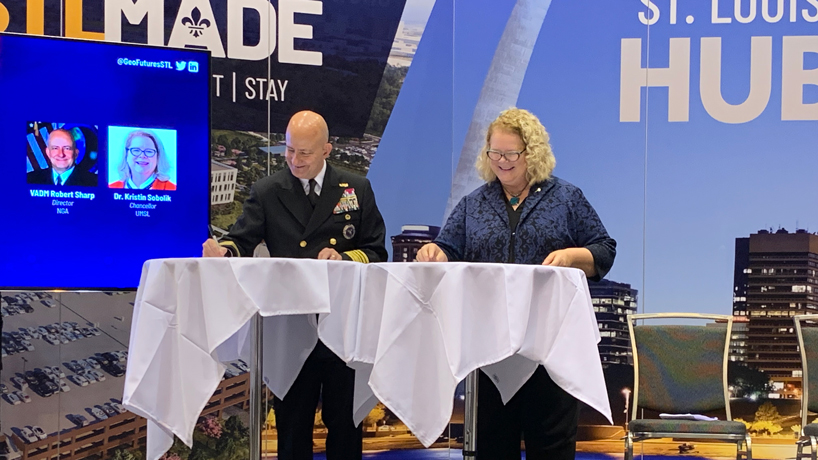
NGA Director Vice Admiral Robert D. Sharp (at left) and UMSL Chancellor sign an Educational Partnership Agreement on Wednesday during a ceremony at the 2021 GEOINT Symposium at America’s Center Convention Complex in St. Louis. (Photos courtesy of Jessica Daues/NGA)
The National Geospatial-Intelligence Agency and University of Missouri–St. Louis are partnering to create a geospatial talent pipeline that supports student learning from kindergarten through college and beyond.
Under a new educational partnership agreement, UMSL faculty and staff will work collaboratively with NGA professionals to develop academic courses and programs in science, technology, engineering and mathematics that will provide students the knowledge and skills needed for careers in geospatial intelligence.
They will also receive assistance from NGA subject matter experts to train K-12 educators in innovative teaching techniques that can help inspire future generations to study STEM and pursue STEM careers. There will be a focus on reaching underrepresented student populations in line with UMSL’s commitment to inclusive excellence.
NGA Director Vice Admiral Robert D. Sharp and UMSL Chancellor Kristin Sobolik signed the agreement Wednesday during the U.S. Geospatial Intelligence Foundation’s GEOINT 2021 Symposium, being held this week at the America’s Center Convention Complex.
NGA Director Vice Admiral Robert D. Sharp delivers prepared remarks at a ceremony to finalize an Educational Partnership Agreement between NGA and UMSL. He described UMSL as uniquely positioned to create a “pathway for diverse talent into our workforce.”
“We’re very serious about recruiting for the workforce of our future – to include increasing diversity and inclusion, and making NGA the gold standard for workplaces in every area,” Sharp said.
During prepared remarks at Wednesday’s signing ceremony, Sharp said UMSL was uniquely positioned to assist and pointed to the university’s commitment to educate students from diverse communities and the high percentage of UMSL graduates who remain in the St. Louis region to live and work. UMSL is ready to help meet the needs not only of NGA but also of the broader geospatial ecosystem growing up around the agency’s new $1.75 billion west campus near downtown St. Louis.
“As a longtime driver of workforce development in our region, UMSL is committed to adapting our programming and preparing our students to support that growth,” Sobolik said. “We envision St. Louis becoming a hub for geospatial technology, not just in Missouri or in the Midwest but globally, and we are eager to work with NGA to help shape that future. We know our students and faculty will benefit greatly from the talent and expertise of NGA professionals.”
UMSL already offers robust programs in computer science, mathematics and physics as well as its joint undergraduate engineering program with Washington University in St. Louis, and UMSL recently added an interdisciplinary bachelor’s degree program in data science and analytics.
The university will explore additional degrees connected to geospatial science and tradecraft.
Chancellor Kristin Sobolik talks about the new Educational Partnership Agreement between UMSL and NGA at a signing ceremony on Wednesday. Sobolik said: “NGA and UMSL share a commitment to the future of St. Louis. Together we seek to make the region into the global hub for geospatial science, technology, and tradecraft and to prepare the United States for the national security challenges of tomorrow.”
“We have a lot of existing courses that have a backbone in geospatial – in sociology and computer science,” said Andrew Kersten, dean of UMSL’s College of Arts and Sciences and a member of St. Louis’ GeoFutures committee. “What I think we need to do is package them together. We need to figure out what the learning outcomes would be for that emphasis area, map them to the coursework and make sure we have a periodicity where students could grab that emphasis area and move through the degree.”
As part of the partnership, NGA and UMSL plan to collaborate on future workshops or conferences, to be held either on NGA’s new campus or at UMSL. NGA will facilitate tours and demonstrations for students and faculty at unclassified facilities on the new campus. It will also suggest research projects suitable for student participation and could provide internship opportunities for students and sabbaticals for faculty members.
NGA and UMSL also have finalized a Collaborative Research and Development Agreement (CRADA) that will create opportunities for UMSL researchers to collaborate with the agency on geospatial research, training and other initiatives aimed at innovation. The UMSL Geospatial Collaborative, created last year, will help coordinate that work.
Two projects are already in development as part of the agreement.
Undergraduate students Marlie Mollett and Emily Sigmund, both majoring in physics, have been working with NGA researcher and UMSL physics PhD alumna Dawn King to develop a higher-resolution gravity map. It uses high-performance computing power to build an AI-gravity prediction tool for areas of the globe where obtaining precise gravity data is otherwise difficult.
History Professor Andrew Hurley and several of his graduate students are beginning a public history project on the site of NGA’s new campus.
“They want to bring forward and to foreground the history of those neighborhoods,” Kersten said. “As that area begins to be redeveloped, we don’t want to forget who we were in moments in time. It’s a way to reverse map. You could go there now and you map that location, but if you took that slider and you brought it back in time, what would be there? What was there was a vibrant community. It still is vibrant, and now it will keep pace with the rest of the city’s development.”
There are expected to be additional educational and research collaborations between NGA and UMSL as the partnership grows.

